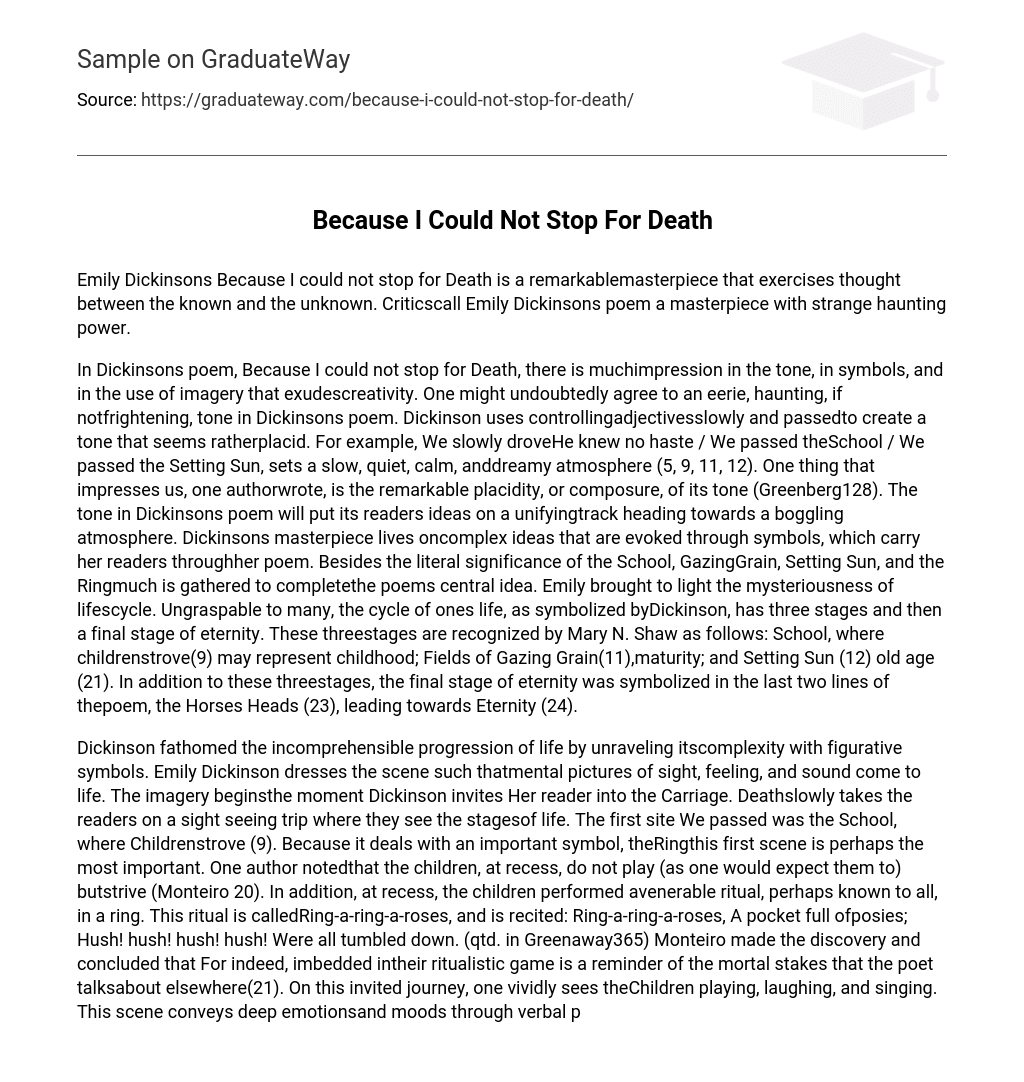Emily Dickinsons Because I could not stop for Death is a remarkablemasterpiece that exercises thought between the known and the unknown. Criticscall Emily Dickinsons poem a masterpiece with strange haunting power.
In Dickinsons poem, Because I could not stop for Death, there is muchimpression in the tone, in symbols, and in the use of imagery that exudescreativity. One might undoubtedly agree to an eerie, haunting, if notfrightening, tone in Dickinsons poem. Dickinson uses controllingadjectivesslowly and passedto create a tone that seems ratherplacid. For example, We slowly droveHe knew no haste / We passed theSchool / We passed the Setting Sun, sets a slow, quiet, calm, anddreamy atmosphere (5, 9, 11, 12). One thing that impresses us, one authorwrote, is the remarkable placidity, or composure, of its tone (Greenberg128). The tone in Dickinsons poem will put its readers ideas on a unifyingtrack heading towards a boggling atmosphere. Dickinsons masterpiece lives oncomplex ideas that are evoked through symbols, which carry her readers throughher poem. Besides the literal significance of the School, GazingGrain, Setting Sun, and the Ringmuch is gathered to completethe poems central idea. Emily brought to light the mysteriousness of lifescycle. Ungraspable to many, the cycle of ones life, as symbolized byDickinson, has three stages and then a final stage of eternity. These threestages are recognized by Mary N. Shaw as follows: School, where childrenstrove(9) may represent childhood; Fields of Gazing Grain(11),maturity; and Setting Sun (12) old age (21). In addition to these threestages, the final stage of eternity was symbolized in the last two lines of thepoem, the Horses Heads (23), leading towards Eternity (24).
Dickinson fathomed the incomprehensible progression of life by unraveling itscomplexity with figurative symbols. Emily Dickinson dresses the scene such thatmental pictures of sight, feeling, and sound come to life. The imagery beginsthe moment Dickinson invites Her reader into the Carriage. Deathslowly takes the readers on a sight seeing trip where they see the stagesof life. The first site We passed was the School, where Childrenstrove (9). Because it deals with an important symbol, theRingthis first scene is perhaps the most important. One author notedthat the children, at recess, do not play (as one would expect them to) butstrive (Monteiro 20). In addition, at recess, the children performed avenerable ritual, perhaps known to all, in a ring. This ritual is calledRing-a-ring-a-roses, and is recited: Ring-a-ring-a-roses, A pocket full ofposies; Hush! hush! hush! hush! Were all tumbled down. (qtd. in Greenaway365) Monteiro made the discovery and concluded that For indeed, imbedded intheir ritualistic game is a reminder of the mortal stakes that the poet talksabout elsewhere(21). On this invited journey, one vividly sees theChildren playing, laughing, and singing. This scene conveys deep emotionsand moods through verbal pictures. The imagery in the final scene, We passedthe Setting Sun, proved very emotional (12). One can clearly picture a warmsetting sun, perhaps, over a grassy horizon. The idea of a setting sun,aftermath a fact of slumber in a cold dark night. When Dickinson passed theSetting Sun, night drew nigh and it was time to go home and sleep.
Symbolically, Her tour of life was short; it was now time forEternitydeath. While sight seeing in the carriage, one can gather, bythe setting of the sun, that this ride was lifelong. It is evident that deathcan creep up on His client. In example, often times, when one experience ajoyous time, time seems to fly. In the same respect, Emily Dickinsonstates Or ratherHe the Setting Sun passed Us (13). In this line,one can see how Dickinson, dressed for the Day, indicates that a pleasanttime was cut short (15,16). Before She knew it, the cold Dews drew quiveringand chill(14). The imagery in this transcendent poem shines great light onsome hidden similarities between life and death. This poem exercises both thethoughts and emotions of its reader and can effectively change ones viewpointof an eternal future. Eternity and Death are two important characters in EmilyDickinsons Because I could not stop for Death. In fact, eternity is astate of being. Dickinson believed in an eternity after death (24). Agreeably,one can say that Emily Dickinsons sole purpose in this poem is to show nofear of death. Emily Dickinsons poem, Because I could not stop forDeath, will leave many readers talking for years to come. This poem then,puts on immortality through an act of mere creativity. Indeed, creativity wascaptured at all angles in this striking piece.
BibliographyDickinson, Emily. Because I could not stop for Death. The CompactBedford Introduction to Literature. Ed. Michael Meyer. 4th ed. Boston:Bedford-St. Martins, 1997. 642-643. Greenaway, Kate.
Ring-a-ring-a-roses. The Oxford Dictionary of Nursery Rhymes. Ed. Iona andPeter Opie. Oxford: Clarendon Press, 1951. 365. Greenberg, John M.
Dickinsons Because I could not stop for Death. Explicator. v49n4.
Summer 1991. 218. Monteiro, George. Dickinsons Because I could not stop for Death.
Explicator. v46n3. Spring 1998. 20, 21. Shaw, Mary N. Dickinsons Because I could not stop for Death.
Explicator. v50n1. Fall 1991. 21. Poetry





